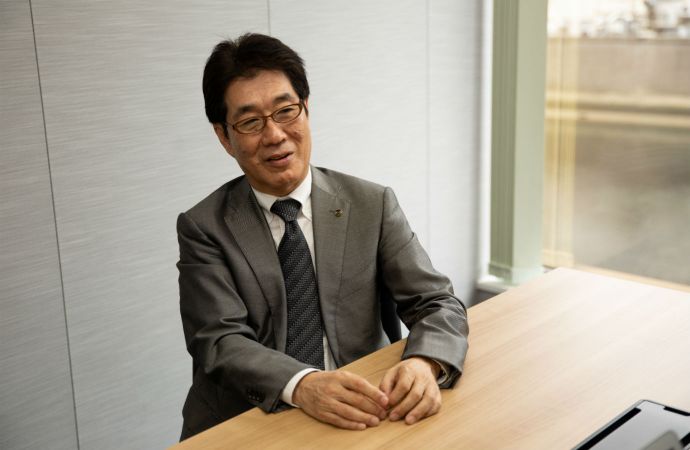Distributor opts for either transcritical CO2 or ammonia/CO2 for new warehouses, depending on the location.

Akio Motohashi, Kokubu Group
In February 2016, Kokubu Group, one of Japan's largest wholesale and distribution companies, opened its West Tokyo distribution center, located in Akishima City on the west side of Tokyo.
The facility was unique for a number of reasons.
First, it was the sixth facility to employ the company's "integrated three-temperature zone" concept, which it established four years prior.
Second, it was one of the company's largest distribution centers – approximately 58,000 m2 (624,306 ft2), with 20,000 m2 (215,278 ft2) of room temperature space, 7,600 m2 (81,805 ft2) for refrigeration, and 9,000 m2 (96,875 ft2) for freezing.
Finally, it was the first facility where Kokubu Group decided to use natural refrigerant technology – Mayekawa’s NewTon ammonia/CO2 system – for its refrigeration and freezing equipment.
Following the opening of the West Tokyo DC, Kokubu Group proceeded to use natural refrigerant systems at successive locations — transcritical CO2 at the Kawaguchi and Funabashi Hinode distribution centers (opened in 2018) and the Obihiro distribution center (opened in June 2019). At these facilities, significant energy savings have been demonstrated compared to its traditional f-gas systems. (All of Kokubu’s transcritical CO2 systems are provided by Nihon Netsugen.)
Driven by these savings and long-term outlook, the company is now confident in moving forward with natural refrigerants at all of its new distribution centers, including
Transcritical CO2 at the Kansai distribution center (planned for September 2019), and ammonia/CO2 at the Okinawa Urasoe distribution center (the provisional name, and planned for January 2021).
"Choosing natural refrigerants for all new distribution centers is our company's policy at the moment," said Akio Motohashi, general manager of the logistics division for Kokubu Group.
The company's facilities in China, Vietnam, Myanmar, and Malaysia also represent an opportunity to phase out of the use of f-gases, however, it is not something the company is focused on currently due to the limited number of technology suppliers and the size of its distribution centers in each country, Motohashi explained.
Initial concerns
Up until the company decided to use natural refrigerants at its West Tokyo DC, Kokubu Group had been using mainly f-gases such as R410A in its refrigerating and freezing equipment.
"There were many internally within the company who were against the introduction of natural refrigerant equipment in the beginning," Motohashi said. "But after clarifying and explaining the advantages and disadvantages in a quantitative and qualitative way, the company decided to move forward with the installations."
The main causes for concern included the high initial cost of the systems and the safety risks for nearby residents in the case of an ammonia leak.
However, he added, "after comparing not just initial costs, but also utility and running costs such as maintenance, from a long-term perspective, it was determined that there were benefits in making the investment."
To understand its operating costs using different refrigerants, Kokubu Group compared monthly electricity bills at three facilities with similar ambient temperatures: its Itabashi DC (which runs on R140A), its West Tokyo DC (NH3/CO2) and its Kawaguchi DC.
The analysis also factored in the cost for water usage at the West Tokyo facility, which employs a water-cooled NH3/CO2 system).
The company found that the transcritical CO2 system ran most efficiently during the cooler months in the winter, while the NH3/CO2 system was able to run very efficiently during the hot summer months.
Overall however, "over the course of the year, we were able to achieve an energy savings of 30% annually compared to our refrigeration systems that used conventional fluorocarbon refrigerants" Motohashi said.
Since 2014, Japan's Ministry of the Environment has provided subsidies to encourage Japan's shift to natural refrigerants, and Kokubu Group has taken advantage of them. "The increase in initial investment cost of the natural refrigerant systems can't be ignored," Motohashi said. "But they can be reduced using the subsidies provided by Japan's Ministry of the Environment."
The ministry’s goal is to contribute to driving down the cost of natural refrigerant equipment to achieve cost parity with conventional f-gas equipment, and to accelerate the spread of the technology. Last December, the ministry confirmed that it had set the budget for natural refrigerant subsidies for fiscal year 2019 (April 2019 through March 2020) at ¥7.4 billion (USD $68 million).
"Although initial costs are higher, with the use of subsidies, reduced maintenance and energy costs, along with the fact that the expected lifetimes of our natural refrigerant equipment are around 20-30 years, we came to the conclusion that there was a benefit to making the investment compared to freon-based refrigeration systems," said Motohashi.
In some cases, Kokubu Group was unable to obtain subsidies, yet moved ahead with the installations of natural refrigerant systems anyway.
"For the Obihiro distribution center, it did not meet the schedule for the subsidy application, Motohashi said. “We also applied for the subsidy for the Kansai distribution center but it was not eligible.” However, he added, “the Kokubu Group will continue to install natural refrigerant equipment as planned even if we do not receive subsidies."
Choosing natural refrigerants for all new distribution centers is our company's policy at the moment."
– Akio Motohashi, Kokubu Group
While environmental and cost considerations factored heavily into the decision-making process at Kokubu Group, when deciding which natural refrigerant systems to use, safety was the number one factor.
"Some of Kokubu Group's distribution centers are located very close to the houses of nearby residents," Motohashi explained. “We came to the conclusion that, when the distribution centers were located near residential areas, we would choose to use CO2-only systems.”
As a result, after an NH3/CO2 system was installed at the West Tokyo facility, the company decided to install transcritical CO2 systems at its Kawaguchi, Funabashi Hinode, and Obihiro DCs, and will install one at the Kansai DC.
On the other hand, for its Okinawa Urasoe DC, located in the southern Japanese island of Okinawa where temperatures are high year-round, the company selected an NH3/CO2 system, which remains consistently efficient in warm ambient conditions.
"In this way, we plan to select the appropriate natural refrigerant system depending on the location of the distribution center and its surrounding environment," said Motohashi.
Related stories





